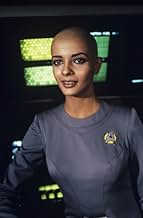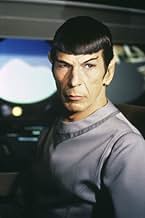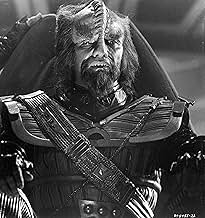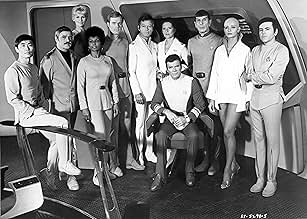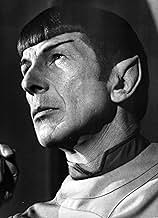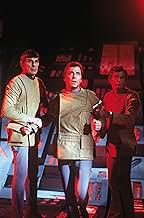El almirante James T. Kirk retoma el mando del USS Enterprise para interceptar una nave extraterrestre de enorme poder cercana a la Tierra.El almirante James T. Kirk retoma el mando del USS Enterprise para interceptar una nave extraterrestre de enorme poder cercana a la Tierra.El almirante James T. Kirk retoma el mando del USS Enterprise para interceptar una nave extraterrestre de enorme poder cercana a la Tierra.
- Dirección
- Guionistas
- Elenco
- Nominado a 3 premios Óscar
- 4 premios ganados y 20 nominaciones en total
John Gowans
- Assistant to Rand
- (as John D. Gowans)
- Dirección
- Guionistas
- Todo el elenco y el equipo
- Producción, taquilla y más en IMDbPro
Opiniones destacadas
Of course the number one most memorable thing about The Motion Picture is the visual effects. The movie manages to show (for long sequences of time) how good the film looks with its budget and it is just incredible to watch. It also helps with the soundtrack being as good as it is. However, although the film has a beautiful look and a great soundtrack, the essential film itself does tend to drag. There are long (and I mean long) periods of time where nothing is happening. It seems like the director and writer were going for a different feel then the normal Star Trek feel. So overall while it does drag, Star Trek The Motion Picture still has some enjoyment to it.
Star Trek: The Motion Picture has its unique place in cinema history as probably the first television series to get a big screen motion picture. Completely due to its special fan base, the like of which has never been seen before or since.
In order to keep the phenomenon going Gene Roddenberry knew he had to have something special to offer and he did. The continuity from the television series was accomplished effortlessly, in fact one of the new characters Commander William Decker is the son of William Windom who was another starship captain in an episode. More I can't say less I give the plot away.
In fact Decker played by Stephen Collins would be commanding the newly fitted Enterprise if it were on a routine mission. But with the threat of an immense alien being on a direct path to earth now Admiral James T. Kirk takes command of the starship himself and with Decker reunites all the old crew from the TV series to meet the threat.
Fans of the original series will also see the similarities in plot between another episode involving the Enterprise meeting up with an old space probe that now has taken on some new functions. The same idea forms the basis of this film's story although in every way it has been expanded and a new ending conceived. Here's a hint, a budding relationship between Collins and new ship's lieutenant Persis Khambatta is what ultimately saves the earth.
Just as you remember them William Shatner, DeForest Kelley, Leonard Nimoy, James Doohan, Nichelle Nichols, George Takei, and Walter Koenig are all back and completely in character as you remember them. The new people Collins, Khambatta and the rest are integrated nicely into the story.
Star Trek: The Motion Picture received three Academy Award nominations, for Best Art&Set Direction, Best Visual Effects, and Best Musical Score. The special effects never overwhelm the telling of a good story which is the primary mission and best asset of the original television series and its successors.
If you're not a Trekkie before seeing this film, you may be come one upon viewing.
In order to keep the phenomenon going Gene Roddenberry knew he had to have something special to offer and he did. The continuity from the television series was accomplished effortlessly, in fact one of the new characters Commander William Decker is the son of William Windom who was another starship captain in an episode. More I can't say less I give the plot away.
In fact Decker played by Stephen Collins would be commanding the newly fitted Enterprise if it were on a routine mission. But with the threat of an immense alien being on a direct path to earth now Admiral James T. Kirk takes command of the starship himself and with Decker reunites all the old crew from the TV series to meet the threat.
Fans of the original series will also see the similarities in plot between another episode involving the Enterprise meeting up with an old space probe that now has taken on some new functions. The same idea forms the basis of this film's story although in every way it has been expanded and a new ending conceived. Here's a hint, a budding relationship between Collins and new ship's lieutenant Persis Khambatta is what ultimately saves the earth.
Just as you remember them William Shatner, DeForest Kelley, Leonard Nimoy, James Doohan, Nichelle Nichols, George Takei, and Walter Koenig are all back and completely in character as you remember them. The new people Collins, Khambatta and the rest are integrated nicely into the story.
Star Trek: The Motion Picture received three Academy Award nominations, for Best Art&Set Direction, Best Visual Effects, and Best Musical Score. The special effects never overwhelm the telling of a good story which is the primary mission and best asset of the original television series and its successors.
If you're not a Trekkie before seeing this film, you may be come one upon viewing.
Star Trek: The Motion Picture - Stardate: 7412.6
Of all the Star Trek films, this is the most impersonal and epic - which necessarily isn't a bad thing. This film really isn't about the Star Trek crew, but about the vast visual effects laden V'Ger and how the Enterprise spends 2+ hours exploring it. The score by Jerry Goldsmith only accentuates this epic-ness - this is one of his best scores and brings a majestic quality to the Star Trek crew. Never really is this film funny (unlike 4) or action-packed (unlike II) but regardless will always have a place in my heart because it tries to be as epic as Star Trek can possibly be. Overall, a 7 out of 10 (mostly because of the state-of-the-art effects of its time in 1979 and a superb score by Jerry Goldsmith RIP).
Of all the Star Trek films, this is the most impersonal and epic - which necessarily isn't a bad thing. This film really isn't about the Star Trek crew, but about the vast visual effects laden V'Ger and how the Enterprise spends 2+ hours exploring it. The score by Jerry Goldsmith only accentuates this epic-ness - this is one of his best scores and brings a majestic quality to the Star Trek crew. Never really is this film funny (unlike 4) or action-packed (unlike II) but regardless will always have a place in my heart because it tries to be as epic as Star Trek can possibly be. Overall, a 7 out of 10 (mostly because of the state-of-the-art effects of its time in 1979 and a superb score by Jerry Goldsmith RIP).
'Star Trek: The Motion Picture', originally released Friday, December 7th, 1979. - ORIGINAL Theatrical Version, 1979, Running Time 2hrs&12mn, Rated "G" by the MPAA - SPECIAL Extended Version, 1983, Running Time 2hrs&23mn, Rated "G" by the MPAA - The DIRECTOR's Edition, 2001, Running Time 2hrs&16mn, Rated "PG" by the MPAA - CONTENT for all three versions includes: Mild Adult Language, Mild Sexual Innuendo and Mild Violence.
My take *** (Out of ****) - or 7/10 on the IMDb Scale.
'Star Trek: The Motion Picture' is the big screen debut of the continuation of the science fiction television series 'Star Trek'. The show chronicled the adventures of the crew of the space-going USS Enterprise. The ship explored the galaxy during a historic five-year mission under the command of the charismatic Captain James T. Kirk. Other crew members included the logical first officer/science officer Spock, a half human/half Vulcan hybrid (Vulcans are an alien race, complete with pointed ears) and the passionate country doctor Leonard "Bones" McCoy. The TV series ran on NBC from 1966 to 1969.
'Star Trek' takes place in the latter half of the 23rd Century. Mankind has formed alliances with many alien races from planets throughout the galaxy, collectively forming The United Federation of Planets. These societies thrive peacefully and continue to develop together and independently. To protect this Federation from hostiles and seek out new lifeforms and new civilizations is Starfleet. This organization is diplomatic and scientific, yet serves as a military force as needed.
The movie opens two & 1/2 years after the completion of the starship Enterprise's five year mission. The spaceship is orbiting Earth, in a dry-dock of sorts, completing a complex overhaul. The planet Earth is in the path of a potential destructive alien intruder. The now Admiral Kirk (William Shatner) doesn't have time to spare during this crisis. He takes a grade reduction to captain, wrestling command of the Enterprise away from a less experienced skipper (Stephen Collins), and sets out to counter the alien threat before it can reach Earth. Most of his original crew has been re-assembled for this undertaking. Shortly after Kirk & team embark to stop the intruder, Spock (Leonard Nimoy) joins them on their quest.
'Star Trek: The Motion Picture' trades in on the action, good drama, suspense and wit the TV series offered to a degree. Kirk & company are here pretty much for the ride, instead of being the leaders they're known as. The movie moves at a slow pace, gradually getting into the intricacies of the alien menace. There's a lot of time adoring spaceships as they travel through space. There's not much in the way of real character development.
Despite the compromises, 'Star Trek: The Motion Picture' works on some level. It's interesting to see the familiar crew in action once again. There are some very fundamental questions asked in the movie that we all have asked ourselves. I found those questions to be intriguing. ST:TMP wants to be intellectual and it succeeds a lot of the time.
Jerry Goldsmith, the film's music composer, provides us with one of the most memorable scores in motion picture history. This is a huge plus for a movie noticeably deficient in personality. This lovely score helps to make up for that. The film almost plays like an elaborate special effects music video set to this grand rousing score. I appreciated the film on this level too.
The special effects by John Dykstra were highly imaginative for the late 1970s. They still hold up well over the decades and continue to enthrall me, especially with the mystery of the alien intruder. The intruder sound effects also succeed in giving me an appropriate sense of awe and dread.
The 2001 Director's Edition is the best version of the movie. The theatrical version was rushed to make the movie's scheduled release date. It was regarded by director Robert Wise as incomplete. 'The Director's Edition' restores Wise's planned vision for the movie. This version streamlines the pace of the movie, adds a little more depth to the characters and has the originally desired sound-mix and completed special effects restored for this edition.
'Star Trek: The Motion Picture' was followed by nine sequels to date and four new TV series. There is an eleventh movie currently in production.
'Star Trek: The Motion Picture' was a shaky start for the launch of the 'Star Trek' film series. It's better to simply except this picture for what it is, rather than for what it isn't. It's not a perfect movie, but it did what it set out to do. It invited me for a journey offering good special effects, a great music score and a beloved crew back on the job. The movie also gave me something to think about. It could have been a better movie, but it's still a marginally satisfying one. Though clearly not for everyone, I recommend it to those who would welcome the philosophical ride it offers.
My take *** (Out of ****) - or 7/10 on the IMDb Scale.
'Star Trek: The Motion Picture' is the big screen debut of the continuation of the science fiction television series 'Star Trek'. The show chronicled the adventures of the crew of the space-going USS Enterprise. The ship explored the galaxy during a historic five-year mission under the command of the charismatic Captain James T. Kirk. Other crew members included the logical first officer/science officer Spock, a half human/half Vulcan hybrid (Vulcans are an alien race, complete with pointed ears) and the passionate country doctor Leonard "Bones" McCoy. The TV series ran on NBC from 1966 to 1969.
'Star Trek' takes place in the latter half of the 23rd Century. Mankind has formed alliances with many alien races from planets throughout the galaxy, collectively forming The United Federation of Planets. These societies thrive peacefully and continue to develop together and independently. To protect this Federation from hostiles and seek out new lifeforms and new civilizations is Starfleet. This organization is diplomatic and scientific, yet serves as a military force as needed.
The movie opens two & 1/2 years after the completion of the starship Enterprise's five year mission. The spaceship is orbiting Earth, in a dry-dock of sorts, completing a complex overhaul. The planet Earth is in the path of a potential destructive alien intruder. The now Admiral Kirk (William Shatner) doesn't have time to spare during this crisis. He takes a grade reduction to captain, wrestling command of the Enterprise away from a less experienced skipper (Stephen Collins), and sets out to counter the alien threat before it can reach Earth. Most of his original crew has been re-assembled for this undertaking. Shortly after Kirk & team embark to stop the intruder, Spock (Leonard Nimoy) joins them on their quest.
'Star Trek: The Motion Picture' trades in on the action, good drama, suspense and wit the TV series offered to a degree. Kirk & company are here pretty much for the ride, instead of being the leaders they're known as. The movie moves at a slow pace, gradually getting into the intricacies of the alien menace. There's a lot of time adoring spaceships as they travel through space. There's not much in the way of real character development.
Despite the compromises, 'Star Trek: The Motion Picture' works on some level. It's interesting to see the familiar crew in action once again. There are some very fundamental questions asked in the movie that we all have asked ourselves. I found those questions to be intriguing. ST:TMP wants to be intellectual and it succeeds a lot of the time.
Jerry Goldsmith, the film's music composer, provides us with one of the most memorable scores in motion picture history. This is a huge plus for a movie noticeably deficient in personality. This lovely score helps to make up for that. The film almost plays like an elaborate special effects music video set to this grand rousing score. I appreciated the film on this level too.
The special effects by John Dykstra were highly imaginative for the late 1970s. They still hold up well over the decades and continue to enthrall me, especially with the mystery of the alien intruder. The intruder sound effects also succeed in giving me an appropriate sense of awe and dread.
The 2001 Director's Edition is the best version of the movie. The theatrical version was rushed to make the movie's scheduled release date. It was regarded by director Robert Wise as incomplete. 'The Director's Edition' restores Wise's planned vision for the movie. This version streamlines the pace of the movie, adds a little more depth to the characters and has the originally desired sound-mix and completed special effects restored for this edition.
'Star Trek: The Motion Picture' was followed by nine sequels to date and four new TV series. There is an eleventh movie currently in production.
'Star Trek: The Motion Picture' was a shaky start for the launch of the 'Star Trek' film series. It's better to simply except this picture for what it is, rather than for what it isn't. It's not a perfect movie, but it did what it set out to do. It invited me for a journey offering good special effects, a great music score and a beloved crew back on the job. The movie also gave me something to think about. It could have been a better movie, but it's still a marginally satisfying one. Though clearly not for everyone, I recommend it to those who would welcome the philosophical ride it offers.
I recently watched this movie for the first time in ten or fifteen years. When I was younger I thought this one was even worse than Star Trek V, because as bad as "The Final Frontier" was, at least it had some action and colour.
The version I just saw wasn't the new Director's Edition, just the old video, but I was still completely surprised by just about everything -- partly because I hadn't seen it in so long, and partly because it's so totally different from all the following Trek movies. I even kinda liked the silly space pajamas everyone wears.
After this, the movie series turned to action-oriented stories, a more militaristic look and feel, and infinitely less challenging concepts. True, the pacing of "Star Trek: The Motion Picture" drags in parts, and the behavior of its stars is a little cold and stiff. But instead of treating us with space battles and phaser shootouts, it gives us long, loving shots of the newly revamped starship Enterprise, and instead of rather tawdry plots grounded in mundane reality, it takes us on a metaphysical voyage into an unknown, bizarre, and palpably huge alien device. The relationship of the three main characters has changed a little after several years apart, and they're each getting used to things all over again: Kirk has to deal with the unfamiliar new ship; Spock, after trying to purge his emotions, must confront his human half; and McCoy is "shanghaied" out of retirement for the trip. Decker and Ilia, the new characters, provide enough interest that they were virtually resurrected as Riker and Troi in Star Trek: The Next Generation.
The sense of scale is important. The cloud surrounding V'Ger is gigantic, and the ship at the heart of the cloud is a whole world to itself. The Enterprise must fly into the cloud and communicate with the ship, and it's the only time in any of the ten movies that the heroes actually confront something new and unknown. This was a staple of the original show, and some of the best episodes of the spin-off series. The subsequent films were content with setting their battles and chases in space, but "Star Trek I" actually wants to explore that space. The question at the centre of the film, posed by Spock, is "Is this all we are? Is there nothing more?" Kirk, Spock, and V'Ger are all searching for an answer to that question.
However, the thing that definitely drags the film down is the sound. The red alert blares every other minute, and mechanical computer voice-overs announce just about everything they possibly can. In the process of updating the ship, they've emphasized the computers and mechanics of the vessel in a way they never had before or since, and the effect is jarring and interesting at the same time. The Enterprise is much more of a physical ship traveling in space, and less of a device to facilitate storytelling.
The visual effects are amazing enough to warrant some digital cleaning, and the movie should be seen in widescreen, preferably on a large television.
It's too bad that this movie wasn't more of a success, because I would like to see more Star Trek in this style. After many years and many TV shows, I admit I've gotten a little tired of space battles.
UPDATE: I recently watched the Director's Edition DVD. The sound effects are fixed, and the film has been re-edited to tighten the pace ever so slightly. The changes made are not on the level of the Star Wars special editions, but they do make the movie more watchable. It's a little more coherent now, and I like it even more.
The version I just saw wasn't the new Director's Edition, just the old video, but I was still completely surprised by just about everything -- partly because I hadn't seen it in so long, and partly because it's so totally different from all the following Trek movies. I even kinda liked the silly space pajamas everyone wears.
After this, the movie series turned to action-oriented stories, a more militaristic look and feel, and infinitely less challenging concepts. True, the pacing of "Star Trek: The Motion Picture" drags in parts, and the behavior of its stars is a little cold and stiff. But instead of treating us with space battles and phaser shootouts, it gives us long, loving shots of the newly revamped starship Enterprise, and instead of rather tawdry plots grounded in mundane reality, it takes us on a metaphysical voyage into an unknown, bizarre, and palpably huge alien device. The relationship of the three main characters has changed a little after several years apart, and they're each getting used to things all over again: Kirk has to deal with the unfamiliar new ship; Spock, after trying to purge his emotions, must confront his human half; and McCoy is "shanghaied" out of retirement for the trip. Decker and Ilia, the new characters, provide enough interest that they were virtually resurrected as Riker and Troi in Star Trek: The Next Generation.
The sense of scale is important. The cloud surrounding V'Ger is gigantic, and the ship at the heart of the cloud is a whole world to itself. The Enterprise must fly into the cloud and communicate with the ship, and it's the only time in any of the ten movies that the heroes actually confront something new and unknown. This was a staple of the original show, and some of the best episodes of the spin-off series. The subsequent films were content with setting their battles and chases in space, but "Star Trek I" actually wants to explore that space. The question at the centre of the film, posed by Spock, is "Is this all we are? Is there nothing more?" Kirk, Spock, and V'Ger are all searching for an answer to that question.
However, the thing that definitely drags the film down is the sound. The red alert blares every other minute, and mechanical computer voice-overs announce just about everything they possibly can. In the process of updating the ship, they've emphasized the computers and mechanics of the vessel in a way they never had before or since, and the effect is jarring and interesting at the same time. The Enterprise is much more of a physical ship traveling in space, and less of a device to facilitate storytelling.
The visual effects are amazing enough to warrant some digital cleaning, and the movie should be seen in widescreen, preferably on a large television.
It's too bad that this movie wasn't more of a success, because I would like to see more Star Trek in this style. After many years and many TV shows, I admit I've gotten a little tired of space battles.
UPDATE: I recently watched the Director's Edition DVD. The sound effects are fixed, and the film has been re-edited to tighten the pace ever so slightly. The changes made are not on the level of the Star Wars special editions, but they do make the movie more watchable. It's a little more coherent now, and I like it even more.
¿Sabías que…?
- TriviaWhen Captain Kirk addresses the crew before launching, many of the extras were noted Star Trek fans, including Bjo Trimble, co-organizer of the letter-writing campaign that kept Viaje a las estrellas (1966) alive for a third season.
- ErroresWhen flying past Jupiter, three consecutive shots of Jupiter and its moons are shown. The first and third are from the POV of the ship as it approaches and passes Jupiter, and show the sunshine on planet and several moons coming from the port aft. The second shot shows the opposite angle of the oncoming ship, and the sunshine on the planet and 4 moons is coming from a different direction on each body, none of them from the port aft.
- Créditos curiososEnd title: "The human adventure is just beginning."
- Versiones alternativasOn November 6, 2001, the Director's Edition supervised by Robert Wise was released on DVD and widescreen VHS, running 136 minutes. The material added to the film consists of the following:
- The landscape of Vulcan was changed to include a yellowish sky and new landscape featuring massive statues. All other footage was tinted gold.
- The matte painting of the Golden Gate Bridge in the scene where Kirk arrives at Starfleet Headquarters was replaced by a new CGI scene that shows Kirk's shuttle arriving at Starfleet. It is actually slightly longer than the original version.
- The matte painting of Starfleet Command was improved with CGI effects, including an original series shuttle launched in the background.
- In a close-up shot when Kirk first sees the new Enterprise from his shuttle, the image of the ship was superimposed over Kirk's face as a reflection in the shuttle's window.
- After Kirk leaves the bridge, a short conversation between Sulu, Uhura and an alien officer was inserted.**
- A new CGI shot of the Earth is shown on the viewscreen when the Enterprise leaves the planet.
- A new CGI effect showing one of the Enterprise's nacelles was inserted into the window when Kirk, Spock and McCoy speak on the observation deck.
- A new CGI shot was inserted which shows V'Ger's second energy torpedo vanishing before it could strike the Enterprise.
- The energy probe that invades the bridge now approaches in a CGI exterior shot.
- A new CGI shot shows the V'Ger vessel entering Earth orbit.
- The scene in which Chekov burns his hand is much longer and shows Lt. Ilia healing him with her empathic powers instead of Nurse Chapel.**
- The long walk to V'Ger was totally redone. There is now a walkway that materializes out of thin air, compared to the endless field in the original version.
- The Enterprise's voyage to the center of V'Ger is slightly extended. It has a scene of Spock sharing a tear "for V'Ger" and Scotty ordered to self-destruct the ship if the landing party is unsuccessful.**
- The small black "empty matte" in the window when Decker and Ilia confront each other in the recreation deck was replaced with a CGI shot of the V'Ger cloud interior.
- The final explosion of V'Ger was slightly extended. The shot from the original version remained intact, but a new element of the vessel imploding its energy for the explosion was added.
- New opening titles were commissioned for the film's opening. The opening titles now have a slight fading effect and are now seen over a background of stars. The text is colored a bright gold, compared to the original version's white.
- The explosion in the wormhole was redone. There is now an exterior shot of the asteroid exploding and the wormhole disintegrating. Additionally, the viewfinder in the next shot is enhanced to show sparks and debris.
- The final message to the audience, "The human adventure is just beginning", was altered. In the original version, the starfield cuts away to a blank title card showing the text. In the Director's Edition, the starfield was extended by a few seconds to allow the text, colored bright gold, to fade into the picture.
- The ending credits were slightly altered. The text, as with the opening titles and the final "human adventure" text, was changed color, from white to a bright gold. Additionally, the music was slightly extended to add new Director's Edition credits.
- An all-new sound mix was commissioned, keeping the music and dialog intact, and adding new effects for almost all scenes. For example, the Enterprise computer voice alarms are now replaced with klaxon sirens, the lightning effects have new echoes, and a blend of Enterprise bridge sound effects from the original Star Trek series, Star Trek II: The Wrath of Khan, and Star Trek VI: The Undiscovered Country have been added into the background of scenes taking place on the bridge. The new mix is in Dolby 5.1 EX Surround.
- The footage from 1979 was digitally restored and remastered, and combined with the new CGI elements.
- The opening overture has been restored to its full length. It is also played over a CGI starfield, rather than the blank screen in the original version.
- A slight dialog alteration was made: In the 1979 and 1983 versions, the V'Ger cloud is said to be "over 82 AUs in diameter" which equals 7.626 billion miles across - much too large for the Enterprise to realistically travel to the heart of the cloud at subwarp speeds within a reasonable length of time. For the Director's Edition, the Epsilon 9 commander's dialog was altered so that the cloud is now said to be a (somewhat) more reasonable "over 2 AUs", or 186 million miles.
- The producers of the Director's Edition submitted the film for re-rating by the MPAA, hoping for a PG rating rather than the original G rating which they believed carried a negative association; the basis for the higher rating was the intensified soundtrack. Oddly, when the original theatrical version was released on DVD and Blu-ray in 2009, it carried no MPAA rating.
- Scenes previously available in the "special longer version."
- ConexionesEdited into Viaje a las estrellas II: La ira de Khan (1982)
- Bandas sonorasTheme from 'Star Trek: The television Series'
Written by Alexander Courage and Gene Roddenberry
Selecciones populares
Inicia sesión para calificar y agrega a la lista de videos para obtener recomendaciones personalizadas
Detalles
- Fecha de lanzamiento
- País de origen
- Sitio oficial
- Idiomas
- También se conoce como
- Star Trek: The Motion Picture
- Locaciones de filmación
- Yellowstone National Park, Wyoming, Estados Unidos(portions of planet Vulcan sequence filmed at Minerva Terrace)
- Productoras
- Ver más créditos de la compañía en IMDbPro
Taquilla
- Presupuesto
- USD 35,000,000 (estimado)
- Total en EE. UU. y Canadá
- USD 82,604,699
- Fin de semana de estreno en EE. UU. y Canadá
- USD 11,926,421
- 9 dic 1979
- Total a nivel mundial
- USD 82,676,805
- Tiempo de ejecución2 horas 23 minutos
- Color
- Mezcla de sonido
- Relación de aspecto
- 2.39 : 1
Contribuir a esta página
Sugiere una edición o agrega el contenido que falta




